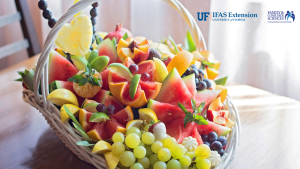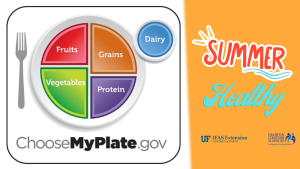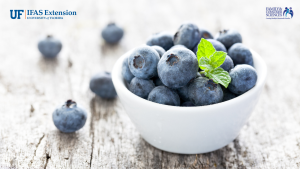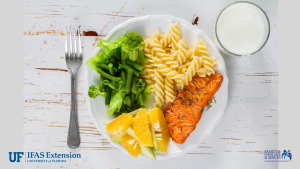Want to get healthier this summer? As part of an overall healthy diet, eating fruits and vegetables, that are lower in calories, instead of some other higher-calorie food, may be useful in helping to lower calorie intake and lower body weight. Eating a diet rich in vegetables and fruits as part of an overall healthy diet may reduce your risk for heart disease, including heart attack and stroke. It may protect against certain types of cancers and other chronic diseases. We all want to prevent disease and maintain good health.

Did you know?
Any fruit or 100% fruit juice counts as part of the MyPlate fruit group. Choose unsweetened fruit juice. Fruits may be eaten fresh, frozen, canned, or dried/dehydrated, and may be whole, cut-up, pureed, or cooked. They also taste great in a smoothie. At least half of the recommended amount of fruit should come from whole fruit, rather than 100% fruit juice.

Any vegetable or 100% vegetable juice counts as part of the MyPlate vegetable group. Low sodium juice is of course lower in sodium. Vegetables may be eaten raw or cooked; fresh, frozen, canned, or dried/dehydrated; and may be whole, cut-up, or mashed. Fresh, crisp vegetables make great snacks. Based on their nutrient content, vegetables are organized into 5 subgroups: dark green, red and orange, beans, peas, and lentils, starchy, and other vegetables. We say, “Eat a rainbow of colorful foods for good health.”

How much fruits and vegetables are recommended daily?
The amount of fruits and/or vegetables you need to eat depends on your age, height, weight, gender, and level of physical activity. For women, the amount can also depend on whether you are pregnant or breastfeeding. Find the right amount for you by going to the MyPlate website for planning guidance. https://www.myplate.gov/myplate-plan
MyPlate is broken down into five food groups. This blog is emphasizing two of those groups: fruits and vegetables. The recommendation is to make one half of your plate fruits and vegetables.

Often, I hear my program participants say that they can’t eat that much fruit and/or vegetables. Note: Normal serving sizes are not that large. Remember fruits and vegetables are not zero calorie foods; they do contain calories. They need to be eaten wisely, by keeping portion control in mind. Fresh grapes vary in size. The recommended serving size for grapes is about 22 seedless grapes or 1 cup, not a pound of grapes at one sitting.

What counts as a cup of fruit or vegetables?
In general, 1 cup of fruit or 100% fruit juice, or ½ cup of dried fruit can be considered as 1 cup from the fruit group. One cup of raw or cooked vegetables or vegetable juice, or 2 cups of raw leafy salad greens can be considered as 1 cup from the vegetable group.
Why is it important to eat fruits and vegetables?
Eating fruits and vegetables provides health benefits, and people who eat more fruits and vegetables as part of an overall healthy diet are more likely to have a reduced risk of some chronic diseases, like heart disease and some types of cancer. Fruits and vegetables provide nutrients vital for health and maintenance of your body. It is important for you to take care of your body.
Most fruit is lower in calories, fat, and sodium. None contain cholesterol, which comes from animal products. Fruits are a source of essential nutrients such as potassium, dietary fiber, folate, and Vitamin C. Adding fruit can help increase intake of fiber and potassium which are important nutrients that many of us do not get enough of in the diet. This includes tasty strawberries, blueberries, apples, pears, watermelon, grapes, raspberries, guanabana, mamey, caimito and more.

Most vegetables are naturally low in fat and calories. (Sauces, dips, oil, butter, margarine, or seasonings may add fat, sodium, and calories.) Vegetables include carrots, colored peppers, green beans, eggplant, boniato, jicama and many more. Vegetables are important sources of many nutrients, including potassium, dietary fiber, folate, Vitamin A, and Vitamin C. Diets rich in potassium may help to maintain a healthy blood pressure. Vegetable sources of potassium include sweet potatoes, white potatoes, white beans, tomato products, soybeans, lima beans, spinach, kidney beans, acorn squash, and yucca. Dietary fiber from vegetables, as part of an overall healthy diet, helps reduce blood cholesterol levels and may lower risk of heart disease. This is all good for each of us to know.

Great news!
- Vitamin A keeps eyes and skin healthy and helps to protect against infections.
- Vitamin C helps heal cuts and wounds and keeps teeth and gums healthy. Vitamin C helps your body absorb iron more easily.

3. Many fruits and vegetables contain water which can help you stay hydrated, during the hot summer months. We all know the heat index is rising and dehydration is a risk factor if we don’t stay properly hydrated.
Gardening Considerations for You
- You can enjoy fresh fruits and vegetables in Florida by growing them in your own yard, even if you live in an urban area like Broward County.
- Don’t have a backyard? You can still garden using containers and grow fruits, vegetables, and herbs almost anywhere.
- You can also learn how to start a vegetable garden. There are many available resources. See the link below in the Read More, Learn More section.
- Gardening can be a great outdoor activity where you can enjoy nature, absorb some Vitamin D from the sun, exercise in the form of bending and stretching, and grow your own food.

Main messages
- Get health benefits this summer! Focus on eating a variety of fruits and vegetables and incorporate them into your meal plan.
- Take colorful and delicious fruits and vegetables with you to work, a picnic, a family cook-out, or beach party.
- If you don’t regularly eat many fruits and vegetables, now is your opportunity to improve your health and nutritional intake.
- Eat healthy at every age!
- Be wise about portion size. Don’t overdo it.
- Life is a journey; choose ways to prevent chronic disease in your lifetime. Eating fruits and vegetables is one of those ways.
- Enjoy special moments in time and engage in positive lifestyle activities and habits.
- Reap the benefits of healthy eating!
Read More. Learn More.
MyPlate – https://www.myplate.gov/
Fruits and Vegetables in Florida – https://sfyl.ifas.ufl.edu/lawn-and-garden/fruits-and-vegetables-in-florida/
Vegetables and Herbs – https://sfyl.ifas.ufl.edu/agriculture/vegetables-and-herbs/
Container Gardening – https://sfyl.ifas.ufl.edu/lawn-and-garden/container-gardening/
Vegetable Gardening – https://sfyl.ifas.ufl.edu/lawn-and-garden/vegetable-gardening/
An equal opportunity institution.
 10
10
